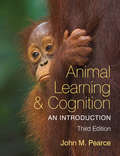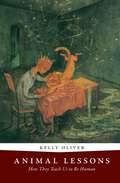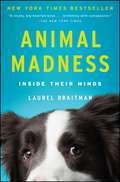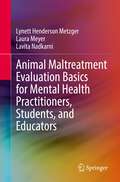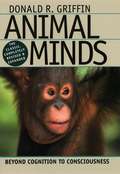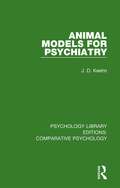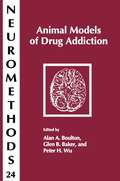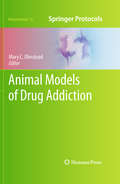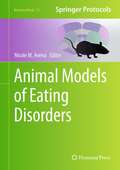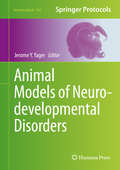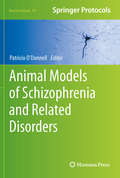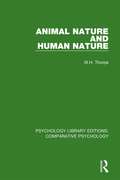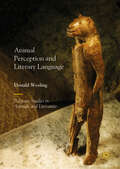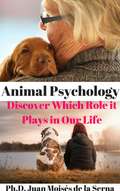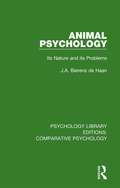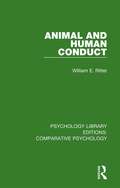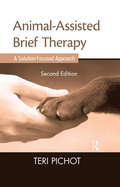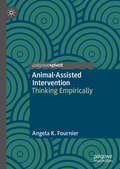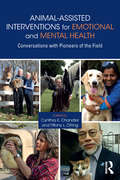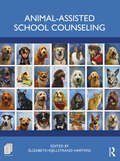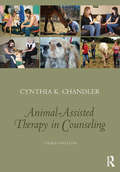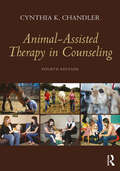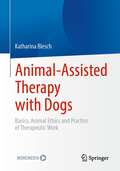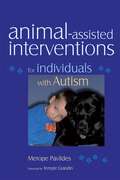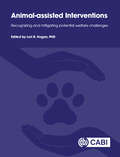- Table View
- List View
Animal Learning and Cognition: An Introduction
by John M. PearceAnimal Learning and Cognition: An Introduction provides an up-to-date review of the principal findings from more than a century of research into animal intelligence. This new edition has been expanded to take account of the many exciting developments that have occurred over the last ten years. The book opens with a historical survey of the methods that have been used to study animal intelligence, and follows by summarizing the contribution made by learning processes to intelligent behavior. Topics include Pavlovian and instrumental conditioning, discrimination learning, and categorization. The remainder of the book focuses on animal cognition and covers such topics as memory, navigation, social learning, language and communication, and knowledge representation. Expanded areas include extinction (to which an entire chapter is now devoted), navigation in insects, episodic memory in birds, imitation in birds and primates, and the debate about whether primates are aware of mental states in themselves and others. Issues raised throughout the book are reviewed in a concluding chapter that examines how intelligence is distributed throughout the animal kingdom. The broad spectrum of topics covered in this book ensures that it will be of interest to students of psychology, biology, zoology, and neuroscience. Since very little background knowledge is required, the book will be of equal value to anyone simply interested in either animal intelligence, or the animal origins of human intelligence. This textbook is accompanied by online instructor resources which are free of charge to departments who adopt this book as their text. They include chapter-by-chapter lecture slides, an interactive chapter-by-chapter multiple-choice question test bank, and multiple-choice questions in paper and pen format.
Animal Lessons: How They Teach Us to Be Human
by Kelly OliverPhilosophy reads humanity against animality, arguing that "man" is man because he is separate from beast. Deftly challenging this position, Kelly Oliver proves that, in fact, it is the animal that teaches us to be human. Through their sex, their habits, and our perception of their purpose, animals show us how not to be them. This kinship plays out in a number of ways. We sacrifice animals to establish human kinship, but without the animal, the bonds of "brotherhood" fall apart. <P><P>Either kinship with animals is possible or kinship with humans is impossible. Philosophy holds that humans and animals are distinct, but in defending this position, the discipline depends on a discourse that relies on the animal for its very definition of the human. Through these and other examples, Oliver does more than just establish an animal ethics. She transforms ethics by showing how its very origin is dependent upon the animal. Examining for the first time the treatment of the animal in the work of Heidegger, Merleau-Ponty, Derrida, Agamben, Freud, Lacan, and Kristeva, among others, Animal Lessons argues that the animal bites back, thereby reopening the question of the animal for philosophy.
Animal Madness: How Anxious Dogs, Compulsive Parrots, and Elephants in Recovery Help Us Understand Ourselves
by Laurel Braitman**“Science Friday” Summer Reading Pick** **Discover magazine Top 5 Summer Reads** **People magazine Best Summer Reads** “A lovely, big-hearted book…brimming with compassion and the tales of the many, many humans who devote their days to making animals well” (The New York Times).Have you ever wondered if your dog might be a bit depressed? How about heartbroken or homesick? Animal Madness takes these questions seriously, exploring the topic of mental health and recovery in the animal kingdom and turning up lessons that Publishers Weekly calls “Illuminating…Braitman’s delightful balance of humor and poignancy brings each case of life….[Animal Madness’s] continuous dose of hope should prove medicinal for humans and animals alike.” Susan Orlean calls Animal Madness “a marvelous, smart, eloquent book—as much about human emotion as it is about animals and their inner lives.” It is “a gem…that can teach us much about the wildness of our own minds” (Psychology Today).
Animal Maltreatment Evaluation Basics for Mental Health Practitioners, Students, and Educators
by Lynett Henderson Metzger Laura Meyer Lavita NadkarniThis book provides a brief introduction to the growing field of animal maltreatment evaluation and treatment, with a special emphasis on clinical training from a forensic psychology perspective. Geared toward mental health practitioners, students, and educators, this broad overview focuses on foundational legal concepts, applications in clinical and psycholegal settings, and emerging perspectives on effective evaluation and treatment. The authors provide practical guidance around “real world” scenarios through the use of clinical case vignettes, highlighting the complexities and need for culturally- and psychologically-informed care in these cases. Key topics include forensic animal maltreatment evaluations (or FAMEs); implications for best practices; challenges for providers, trainees, and supervisors; and future directions for the field.
Animal Minds: Beyond Cognition to Consciousness
by Donald R. GriffinIn Animal Minds, Donald R. Griffin takes us on a guided tour of the recent explosion of scientific research on animal mentality. Are animals consciously aware of anything, or are they merely living machines, incapable of conscious thoughts or emotional feelings? How can we tell? Such questions have long fascinated Griffin, who has been a pioneer at the forefront of research in animal cognition for decades, and is recognized as one of the leading behavioral ecologists of the twentieth century. With this new edition of his classic book, which he has completely revised and updated, Griffin moves beyond considerations of animal cognition to argue that scientists can and should investigate questions of animal consciousness. Using examples from studies of species ranging from chimpanzees and dolphins to birds and honeybees, he demonstrates how communication among animals can serve as a "window" into what animals think and feel, just as human speech and nonverbal communication tell us most of what we know about the thoughts and feelings of other people. Even when they don't communicate about it, animals respond with sometimes surprising versatility to new situations for which neither their genes nor their previous experiences have prepared them, and Griffin discusses what these behaviors can tell us about animal minds. He also reviews the latest research in cognitive neuroscience, which has revealed startling similarities in the neural mechanisms underlying brain functioning in both humans and other animals. Finally, in four chapters greatly expanded for this edition, Griffin considers the latest scientific research on animal consciousness, pro and con, and explores its profound philosophical and ethical implications.
Animal Models for Psychiatry (Psychology Library Editions: Comparative Psychology)
by J. D. KeehnOriginally published in 1986, in this work Professor Keehn assesses the contributions of experimental psychology and ethology to psychiatric theory and practice at the time. He discusses the status of animals in psychopathology, and describes a number of animal clinical pictures, covering both abnormal movements and convulsions, and spontaneous behavioural disorders. He also includes animal models of such psychiatric illnesses as neurosis, psychosis, drug addiction and disorders of childhood, and examines the nature of mental illness and the status of psychiatric diagnosis. The book includes an evaluation of the ethics of experimental research with animals and a summary of humane experimental procedures. Animal Models for Psychiatry will be of special interest to psychiatrists, clinical and physiological psychologists, behavioural pharmacologists, and to veterinarians.
Animal Models of Drug Addiction (Neuromethods #24)
by Alan A. Boulton Glen B. Baker Peter H. WuA comprehensive guide to the use of animal models for understanding the many facets of drug and alcohol abuse-problems that are now worldwide health concerns. Expert investigators have contributed state-of-the-art chapters on the use of animal models for research on substance abuse.
Animal Models of Drug Addiction (Neuromethods #53)
by Mary C. OlmsteadOur understanding of addiction and how it is treated has advanced remarkably over the past decades, and much of the progress is related directly to animal research. This is true for both the behavioural aspects of drug use as well as the biological underpinnings of the disorder. In Animal Models of Drug Addiction, experts in the field provide an up-to-date review of complex behavioural paradigms that model different stages of this disorder and explain how each test is used to effectively replicate the progression of drug addiction. This detailed and practical book begins with the most common laboratory measures of addiction in animals, including intracranial self-stimulation (ICSS), drug self-administration, place conditioning, and sensitization. Later chapters describe how these paradigms are used to model the progression of drug addiction, providing insight into the clinical symptomatology of addiction from acquisition of drug use through compulsive drug taking to withdrawal and relapse. Written for the popular Neuromethods series, the contributions offer both methodological detail and a theoretical perspective, appealing to readers familiar with preclinical research on drug addiction as well as those who are newcomers to the field. Cutting-edge and authoritative, Animal Models of Drug Addiction will serve as a basis for future vital research that links the bench to the bedside in the crucial treatment of drug addiction.
Animal Models of Eating Disorders (Neuromethods #74)
by Nicole M. AvenaThe growth of the field of eating disorder research has led to a vast array of empirical articles, and the development of new animal models that can be used to study these disorders continues to stimulate new research. Animal Models of Eating Disorders serves as a collection of detailed techniques contributed by experts in the field who are well-versed in the development and implementation of these models. Since eating disorders are complex and likely due to a combination of environmental, genetic, and social causes, the detailed chapters of this volume have been designed to highlight different contributing factors. Collectively, these chapters give a comprehensive and representative overview of both recently developed and classic methodologies used in the study of eating disorders. Written for the popular Neuromethods series, this work contains the kind of thorough description and implementation advice that promises successful results. Authoritative and practical, Animal Models of Eating Disorders aims to aid researchers in the use of animal models to assist in their investigation and characterization of the behaviors and neurochemical alterations associated with these devastating disorders.
Animal Models of Neurodevelopmental Disorders (Neuromethods #104)
by Jerome Y. YagerProviding a spectrum of models that is reflective of the various species that can be utilized in experimentation on disorders across a broad range of developmental disabilities, this volume collects expert contributions involved in investigation of the causes, outcomes, treatment, and prevention. Animal Models of Neurodevelopmental Disorders explores models of perinatal hypoxia-ischemia/cerebral palsy and stroke, autism spectrum disorder, fetal alcohol syndrome, as well as mental retardation. Written in the popular Neuromethods series style, chapters include the kind of detail and key advice from the specialists needed to get successful results in your own laboratory. Practical and authoritative, Animal Models of Neurodevelopmental Disorders serves to introduce and entice those interested in better understanding and treating these disorders to the vital animal model world of investigation.
Animal Models of Schizophrenia and Related Disorders (Neuromethods #59)
by Patricio O'DonnellAnimal models of schizophrenia and other major psychiatric disorders have been sought for decades, and, as a result, we are now facing new vistas on pathophysiology that could lead to novel therapeutic approaches and even hint at possible preventive strategies. Animal Models of Schizophrenia and Related Disorders presents an overview of the information that can be obtained with several different models and a detailed account of how to generate such models in order to ensure that the manipulations used to model schizophrenia-relevant phenomena are used consistently across laboratories. This detailed volume features pharmacological models such as non-competing NMDA antagonists, emphasizing their use in vitro, neurodevelopmental models such as the neonatal ventral hippocampal lesion and the antimitotic MAM, models that reproduce environmental factors such as neonatal hypoxia, vitamin D deficits, and prenatal immune activation, as well as several different genetic model approaches. As a volume in the Neuromethods series, this volume contains the kind of detailed description and implementation advice that is crucial for getting optimal results. Practical and cutting-edge, Animal Models of Schizophrenia and Related Disorders highlights the successes in the use of animal models to gain insight on pathophysiological mechanisms of relevance to major psychiatric disorders in the hope of inspiring investigators to expand the research and test targets that could restore or ameliorate function.
Animal Nature and Human Nature (Psychology Library Editions: Comparative Psychology)
by W.H. ThorpeOur views on human nature are fundamental to the whole development, indeed the whole future, of human society. Originally published in 1974, Professor Thorpe believed that this was one of the most important and significant topics to which a biologist can address himself, and in this book he attempts a synthetic view of the nature of man and animal based on the five disciplines of physiology, ethology, genetics, psychology and philosophy. In a masterly survey of the natural order he shows the animal world as part of, yet distinct from, the inanimate world. He then treats aspects of the animal world which approach the human world in behaviour and capabilities, examining simple organisms, communications in vertebrates and invertebrates, innate behaviour versus acquired behaviour, and animal perception. In the second part of the book he deals with those aspects of human nature for which there is no analogy and which constitute man’s uniqueness – his consciousness of his past, his awareness of his future and his desire to understand the meaning of his existence. The primary facts which demonstrate the importance of this book arise from the ever-growing power of man over his environment and his apparent inability to foresee and cope with the dangers of uncontrolled population growth on the one hand and the wildly irrational waste and degradation of the natural resources of the world on the other. Professor Thorpe believes that an immense responsibility lies with literate men of good will, particularly scientists, to convince man that he is the spearhead and custodian of a stupendous evolutionary process. Animal Nature and Human Nature integrates scientific fact with sound theological thought in an attempt to fulfil, in a manner previously impossible Pascal’s injunction that: ‘It is dangerous to show man too clearly how much he resembles the beast without at the same time showing him his greatness. It is also dangerous to allow him too clear a vision of his greatness without his baseness. It is even more dangerous to leave him in ignorance of both. But it is very profitable to show him both.’
Animal Perception and Literary Language (Palgrave Studies in Animals and Literature)
by Donald WeslingAnimal Perception and Literary Language shows that the perceptual content of reading and writing derives from our embodied minds. Donald Wesling considers how humans, evolved from animals, have learned to code perception of movement into sentences and scenes. The book first specifies terms and questions in animal philosophy and surveys recent work on perception, then describes attributes of multispecies thinking and defines a tradition of writers in this lineage. Finally, the text concludes with literature coming into full focus in twelve case studies of varied readings. Overall, Wesling's book offers not a new method of literary criticism, but a reveal of what we all do with perceptual content when we read.
Animal Psychology - Discover which role it plays in our life
by Juan Moises de la Serna Julia Kräutler & Diego VelardeIn this book you will find an approach to the animal kingdom, from a psychological perspective, showing differences and similarities with humans. Likewise, it's commented about the actual experimental work in the search for diseases' cures and disorders' treatments. Finally, you will find an approach to animal-assisted therapy for various psychopathologies.
Animal Psychology: Its Nature and its Problems (Psychology Library Editions: Comparative Psychology)
by J.A. Bierens de HaanOriginally published in 1948, the author follows the idea that the instincts are "the spring and basis of all animal behaviour (with the exception perhaps of play), and therewith the core of the animal’s mind, and that individual experience, gathered by the animal in the course of its life, may influence and reconstruct these instincts, so as to guide, in the form of intelligence and understanding, this behaviour along new (i.e. innate) paths. Thus, instinct and experience become the pillars upon which animal behaviour is built up; instinct, intelligence, and understanding form a triad round which the facts of the psychology of animals may be grouped. As a foundation of all this the author first tries to prove the good right of a real and genuine animal psychology, not hampered by objectivistic and behaviouristic scruples, while in a final chapter, by way of conclusion, he tries to give an image of how the world of the animal is built up."
Animal and Human Conduct (Psychology Library Editions: Comparative Psychology)
by William E. RitterOriginally published in 1928, this title looks at the link between animal and human conduct. It had long been recognized on the basis of their activities that many animals possess minds, and that these are similar in a considerable number of respects to human minds. According to the author, this book looks at man’s position within nature from the perspective of a naturalist, rather than a psychologist or philosopher. He has attempted to describe the working of mind and body in human beings and in other living things; to examine critically the mental technique involved in such descriptions; and to reason broadly as to the bearings of the facts and processes on human life. Now it can be read and enjoyed in its historical context.
Animal-Assisted Brief Therapy: A Solution-Focused Approach
by Teri PichotThis book provides an overview of Animal-Assisted Activities (AAA) and Animal-Assisted Therapy (AAT) and demonstrates how they can be incorporated into solution-focused treatment programs. Pichot, focusing on the use of therapy dogs, starts with a discussion of the basics of AAA/T and solution-focused therapy, as well as what every practitioner should know about dogs before partnering with them. Successfully combining all of this into an effective treatment program is considered next. Pichot draws upon her own experience developing an AAA/T program in the substance abuse counseling program at a county public health agency to illustrate the effective implementation of such a program and the struggles and lessons learned in doing so. Using AAA/T with special populations, cultural considerations, and the impact a therapy dog can have on the handler. New in this edition are client scenarios that demonstrate the therapist’s thought process when making clinical decisions about when and how to use a therapy dog. Sample forms and treatment plans are also provided that professionals can use to modify or structure in their work with clients. The concepts and information provided in this valuable guide will be helpful for any therapist regardless of whether he or she is in private practice or working in an agency setting.
Animal-Assisted Intervention: Thinking Empirically
by Angela K. FournierThis book brings the animal into the scholarly discussion of animal-assisted therapy and other interventions. Challenging the current reliance on outcome studies, the author offers a new way of thinking empirically about animal-assisted interventions—analysis of human-animal interaction as a critical component. Through empirical demonstrations from laboratory and applied settings, the book encourages practitioners and scholars to undergo a deeper examination of the basic interactions that occur between clients or patients and therapy animals. Dr. Fournier provides new ideas on measurement, experimentation, and interpretation of human-animal interaction, aimed at identifying the role of the animal in interventions for human health and well-being.
Animal-Assisted Interventions for Emotional and Mental Health: Conversations with Pioneers of the Field
by Cynthia K. Chandler and Tiffany L. OttingAnimal-Assisted Interventions for Emotional and Mental Health provides a unique opportunity to learn from a variety of leaders in the field. Leading scholar Dr. Cynthia Chandler and colleague Dr. Tiffany Otting present interviews with pioneering experts from the U.S., U.K., Israel, India, and Hong Kong, revealing key beliefs, values, and ideas that are fundamental to animal-assisted interventions. Their words will inspire and guide current and future generations of practitioners, teachers, and researchers.
Animal-Assisted School Counseling
by Elizabeth Kjellstrand HartwigAnimal-Assisted School Counseling (AASC) is a hands-on resource that provides invaluable information for school counselors interested in partnering with a therapy animal on campus to help students meet social and emotional goals. This book presents a wealth of resources for school counselors and school-based mental health practitioners to incorporate animal partners on school campuses with individual students and groups and in classroom and schoolwide settings. Using the American School Counselor Association (ASCA)National Model framework, this book presents AASC interventions that can be implemented as part of the multitiered system of support to address students’ mental health needs. The text also meets the important demand for accountability in school counseling by providing resources for assessing the effectiveness of AASC interventions for meeting student and school outcome goals. Addressing such issues as getting school district buy-in, choosing an animal partner, preparing the school for an animal partner, theoretical applications of AASC, and student-affirming AASC services, the book is organized such that each chapter builds upon the next so school counselors understand what steps to take to become an effective AASC team. Ideal for the school counselor, social worker, or psychologist who may not have specific training in AASC, this book will encourage school mental health practitioners to seek out training programs to become an AASC team.
Animal-Assisted Therapy in Counseling
by Cynthia K. ChandlerThe third edition of Animal-Assisted Therapy in Counseling is the most comprehensive book available dedicated to training mental health practitioners in the performance of animal assisted therapy in counseling (AAT-C). New to this edition is discussion of the human-animal relational theory, a new theory dedicated to the practice of AAT-C. This edition also has added applications for supervision and includes the most recent research and practice. Consistent with previous editions, a variety of animal-assisted interventions are described with case examples provided in a variety of settings with different types of animals. This unique resource is an indispensable guide for any counselor or psychotherapist looking to develop and implement AAT techniques in practice.
Animal-Assisted Therapy in Counseling
by Cynthia K. ChandlerThe fourth edition of Animal-Assisted Therapy in Counseling is the most comprehensive book available dedicated to training mental health practitioners in the performance of animal-assisted therapy in counseling.This edition includes material on real-world animal-assisted interventions featuring counselor-client dialogues and sample therapeutic opportunities. Each chapter includes the most recent research and practice, and a wide variety of case examples present animal-assisted interventions in different settings with different types of animals.This unique resource is an indispensable guide for any counselor or psychotherapist looking to develop and implement animal-assisted therapy techniques in practice.
Animal-Assisted Therapy with Dogs: Basics, Animal Ethics and Practice of Therapeutic Work
by Katharina BleschAnimal-assisted therapy has been the talk of the town for several years and is increasingly being integrated into the psychotherapeutic treatment of people. But how exactly can dogs support psychotherapeutic work? How can animal welfare and human welfare be combined? Which dogs are suitable and how are they prepared? This book provides a practical and lively insight into therapeutic work with dogs. In addition to an overview of the basics as well as animal welfare and ethical aspects of dog-assisted therapy, concrete exercises in the context of dog-assisted self-confidence training are described pictorially and by video, providing inspiration for therapeutic work in various institutions and situations.
Animal-assisted Interventions for Individuals with Autism
by Temple Grandin Merope PavlidesThis book looks at how therapies involving animals can be used to help individuals with autism to develop skills, including sensory and social skills, to manage challenging behaviors, and improve quality of life. Whether participating in therapeutic horseback riding, utilizing a trained service dog, visiting a dolphin therapy center, or simply experiencing companion animal therapy, people with autism can reap a multitude of benefits from interaction with furry, feathered, and finned friends. Merope Pavlides relates the success stories of different animal-assisted interventions, as well as noting the challenges of working with particular animal species. She also emphasizes the importance of tailoring interventions to the specific needs of the individual and of monitoring progress. With recommendations for resources and further reading, this book will be of great interest to people with autism, their parents, and the professionals who work with them.
Animal-assisted Interventions: Recognizing and Mitigating Potential Welfare Challenges
by Temple Grandin Helen Lewis Amy Johnson Susan D. Greenbaum Ashley Thompson Aubrey H. Fine Veronica Lac Patti Anderson Nicky Barendrecht-Jenken Anna Van Berg Darlene Blackman Eileen Bona Donna Clarke Linda Chassman Craddock Yvonne Eaton-Stull Cynnie Foss Angela Fournier Megan French Nina Ekholm Fry Lisa-Maria Glenk Taylor Chastain Griffin Joy R. Hanson Terri Hlava Ann R. Howie Batya Gugenheim Jaffe Suzanne M. Kapral Jean Kirnan Ursula A. Kohl Elizabeth A. Letson Kirsty MacQueen Arieahn Matamonasa-Bennett Angela M. Moe Julie Ann Nettifee Zenithson Ng Brittany Panus Caiti Peters Laura Poleshuck Missy Reed Elizabeth Ruegg Brenda Rynders Sarah Schlote Shira Smilovici Risë VanFleet Melissa Y. Winkle Katrina WinsorThis is a practical book exploring how to conduct animal assisted intervention (AAI) in ways that protect and prioritize animal and human welfare. This resource is for social scientists (e.g., psychology, social work, human development and family studies, etc.), as well as ethologists and animal behaviour and welfare students and practitioners. The book is a series of short chapters that depict a wide array of AAIs and their potential welfare concerns. The chapters include descriptions of the AAI offered, the welfare challenges, and ways to successfully mitigate these challenges. This book also covers critical topics including therapy animals' aging, retirement, and death as well as ethical issues including animal consent. Species include not only dogs, but horses, rabbits, and other small animals (e.g., guinea pigs, mice, etc.). Types of AAI involve individual interventions as well as crisis dogs (those who help after natural and man-made disasters), and residential animals. The book is designed to be a practical, engaging book with links to video and examples of real-life situations. It is evidence-based, yet user-friendly and directly applicable to students and practitioners. This highly practical and engaging book with examples of real life situations, videos and case studies, explores how to conduct animal assisted interventions in ways that protect and prioritize animal and human welfare. The book: · Explores how to conduct animal assisted intervention (AAI) in ways that protect and prioritize animal and human welfare. · Discusses potential welfare challenges including how to advocate for the animal, animal consent, and the animal's aging, retirement, or death. · Evidence based approach to mitigating welfare concerns for a wide range of therapy animals including dogs, horses, rabbits, rodents, and exotic animals - and their recipients. An invaluable resource for ethologists and animal behaviour and welfare students and practitioners, as well as social scientists (e.g., psychology, social work, human development and family studies).
